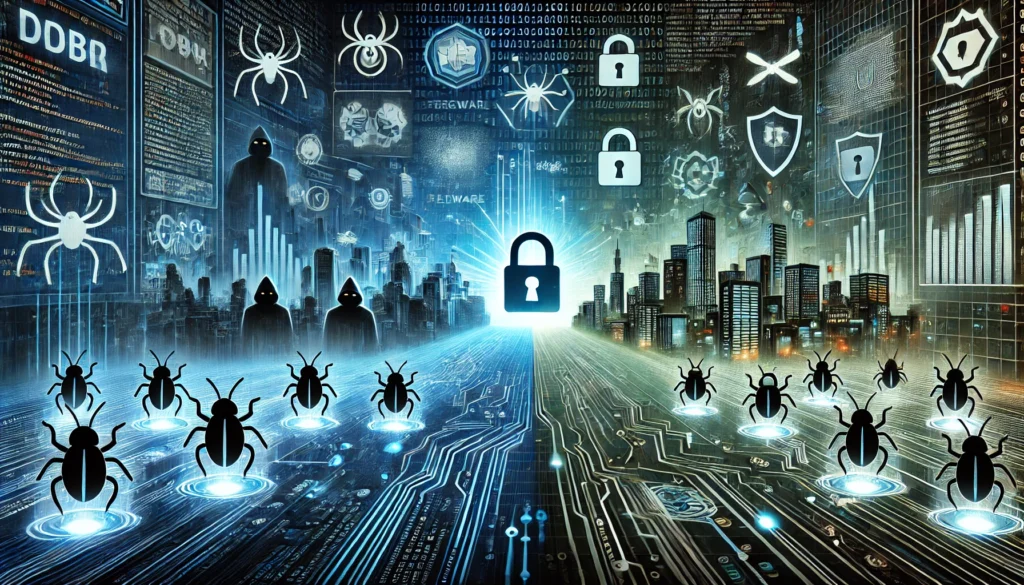Published on: 12th October 2024
Authored by: Yukta Rao
Guru Gobind Singh Indraprastha University
ABSTRACT
The rapid advancement of technology has fundamentally altered the internet landscape, presenting opportunities as well as challenges for legal systems throughout the globe. In order to assess how well-suited the present legal system is to address the difficulties provided by blockchain, artificial intelligence (AI), the internet of things (IoT), and quantum computing, this paper examines the complicated link between emerging technologies and Indian cyber law. The report looks closely at the legal implications of these technologies and offers recommendations for future adjustments that might make Indian Cyber Law more resilient to setbacks. The literature research builds the foundation by examining India’s present cyber laws and the historical implications of past technological developments on legal frameworks. Identifying gaps in the current legislation, the
Our modern society offers a plethora of conveniences. Thanks to current advances, we can go anywhere in the globe. Crime occasionally stems from modern innovation. Among them is cybercrime. Around the world, cybercrime is rampant. The phrase “cybercrime” refers to a variety of illegal actions, including breaking into networks, obtaining private information from banks, stealing papers, and sending money to personal accounts. The use of computers for governance, industry, and pleasure has increased the significance of cybercrime, particularly on the Internet. The use of a computer to facilitate criminal conduct, such as identity theft, fraud, the trafficking of child pornography, and the trafficking of intellectual property, is known as cybercrime, often known as computer crime.
INTRODUCTION
Cybercrimes, often known as digitalised crimes, are offences perpetrated via the use of electronic devices, such as cellphones or networked computers. Cybercrimes can be committed for a variety of motives, such as sexual exploitation, prime fraud, spread malware, illegal information, illegal images or retaliation etc. The number of cybercrime cases in India has also been increasing exponentially over time. This number reflects the increase in subscriptions every day. According to a report in the Economic Times, the Indian Cyber Crime Coordination Centre (I4C) reported that, on average, 7,000 cybercrime complaints were recorded daily in May 2024. This represents a significant surge of 113.7 per cent compared to the period between 2021 and 2023, and a 60.9 per cent increase from 2022 to 2023.[1]
Technology’s exponential growth has had a significant impact on the constantly changing field of cybercrime, bringing with it both new opportunities and difficulties. Technological innovations like bitcoin, networked devices, and artificial intelligence have led to more complex cyber threats in recent years. This article examines the complex connections between crime and technological advancements, demonstrating how the former provide up new opportunities for the latter. Because of the digital revolution, more laws are required to protect people, companies, and countries against cybercrime. Cybercriminals must be dissuaded and found guilty through the implementation of strong laws and regulations. Laws need to be draughted and updated keeping in mind how cyber threats are always changing. The importance of legislation in ensuring frameworks for dealing with the ever-changing nature of cybercrime.
TECHNOLOGICAL ADVANCEMENTS CONTRIBUTING TO NEW FORMS OF CYBER CRIMES:
The number of cyberthreats has increased in tandem with the exponential growth of technological innovation in the 21st century. Criminals now have more opportunities due to an increased technological advancement such as cloud computing, the IoT, and AI. Cybercriminals may now use Internet of Things (IoT) devices as entry points, and cloud-based services have increased the vulnerability of data storage and access.[2]
One of the cybersecurity concern that is especially concerning is the weaponization of AI. More potent technologies are becoming available to cybercriminals, including malware powered by machine learning, automated attacks, and deepfakes. These developments not only make attacks bigger and more complicated, but they also make it harder to assign blame and identify them.
The emergence of cryptocurrency has revolutionised the financial aspect of cybercrime. Digital currencies provide a pseudo-anonymous means of transaction, making them more vulnerable to ransomware attacks and money laundering.
Laws must be regularly revised to reflect the dynamic nature of cyber dangers brought on by advances in technology. The historical development of cybercrime emphasises the need for adaptable legal frameworks capable of addressing the intricate problems brought up by contemporary technology. In the sections that follow, we will look at the current state of legislation and the adjustments required to handle cyber hazards as they arise.
IMPACT OF GLOBALIZATION ON CYBER CRIME:
Information and communication technology have accelerated the growth of globalisation. The development and innovation of technologies such as television, the internet, and telecommunications devices etc has led to a rise in global participation among individuals, businesses, and governments. The process via which organisations and groups, whether they are corporations or not, begin to operate globally or internationally is known as globalisation. Globalisation facilitates the flow of ideas and the exchange of goods, services, knowledge, information, ethics, and cultural practices among people from different nations. Globalisation facilitates cross-border cooperation and relationships between people and businesses. [3]
Globalisation has many detrimental effects in addition to its beneficial effects, which are progressive and evolutionary. ICT undoubtedly contributed to the acceleration of globalisation, but it was also the confluence of these two factors that gave rise to “Cyber Crimes.” While globalisation has promoted the exchange of cultures, attitudes, and beliefs, it has also propagated ideas about new ways to commit crimes and immoral behaviour.
The quick rise of globalisation and ICT has led to criminals developing new methods and strategies for committing crimes. While traditional crimes did not require computers or the internet, technological advancements have made it possible for someone to steal personal information from his home. He is not obliged to go to the victim’s home. This is referred to as data theft and hacking in the internet world. Theft or extortion are easy crimes to perform when the victim cannot see the perpetrator, but when the crime is done virtually, it is simpler for the perpetrator to evade detection by law enforcement.
LEGISLATION TO TACKLE CYBER CRIME IN INDIA:
India complies with five primary categories of cybersecurity regulations. These comprise the Cybersecurity Framework (NCFS), the Companies Act of 2013, the Information Technology Rules (IT Rules), the Indian Penal Code of 1860 (IPC), and the Information Technology Act 2000(IT act).
The first cyber legislation that the Indian Parliament has authorised is the one that was created under the IT Act of 2000. It draws attention to fines and punishments that the Indian Parliament has imposed to protect the e-banking, e-governance, and e-commerce industries.
INFORMATION TECHNOLOGY ACT 2000:
The Information Technology Act of 2000, a legislative framework put forth by the Indian Parliament, is the main piece of law in India that addresses cybercrime and internet commerce. It was developed based on the United Nations Model Law on Electronic Commerce from 1996 (UNCITRAL Model) in order to guarantee the legal conduct of digital transactions and the decrease of cybercrimes. [4]
Objectives:
1.Encourage the effective electronic delivery of government services or make it easier for businesses and normal people to deal digitally.
2.To provide a safe online environment, penalise cybercrimes such as data theft, identity theft, cyberstalking, and so on.
3.Create guidelines and policies that keep an eye on online behaviour and electronic communication and commerce platforms.
4.Encourage the growth, entrepreneurship, and innovation in the Indian IT/ITES industry.
Advantages of the Act:
Before the Act was passed, emails, SMS, and other comparable means of communication were not recognised by the law and could not be presented as evidence in court. However, the IT Act, which was passed in 2000, gave electronic communications legal standing.
The legalisation of digital signatures has made it simpler to conduct transactions online and confirm someone’s identification there.
In the case of unauthorised entry or hacking into an organization’s IT infrastructure or networks, the company is entitled to statutory remedies.
The Act recognises and punishes a number of cybercrimes that were not previously covered by any laws, including hacking, spamming, identity theft, phishing, and more.
Disadvantages of the Act:
The Information Technology Act of 2000 does not address issues related to domain names or the rights and responsibilities of domain owners.
Although patent and copyright disputes are frequent in India, the Act does not protect intellectual property rights pertaining to computer networks and programs.
Cyberstalking, cyberfraud, chat room abuse, and theft of internet hours are among the many cybercrimes that are not covered by this Act.
Moreover, the IT Act does not address significant issues like content management and privacy.
CONCLUSION
The effectiveness of cyber security legislation is a complex issue in India. While the existing frameworks has made significant strides, challenges still prevail. Continuous evaluation, adaptations and a commitment to international collaborations are essential to strengthen India’s cybersecurity defences and safeguarding its digital future. a comprehensive cybersecurity law combined with rombust enforcement mechanisms and a focus on individual privacy will be pivotal in achieving this role.
[1] (TOI Tech Desk / TIMESOFINDIA.COM / Updated: May 28)
[2] Impact of technology on cybercrime legislation by – aryan raj (no date a) image. Available at: https://www.ijlra.com/paper-details.php?isuur=1753 (Accessed: 29 August 2024).
[3] Banerjee, S. (2021) Impact of globalization on Cybercrimes, iPleaders. Available at: https://blog.ipleaders.in/impact-of-globalization-on-cybercrimes/#:~:text=Globalization%20has%20benefited%20industrialized%20countries,few%20of%20the%20positive%20consequences. (Accessed: 29 August 2024).
[4] It Act 2000: Objectives, features, amendments, sections, offences and penalties (no date) cleartax. Available at: https://cleartax.in/s/it-act-2000 (Accessed: 29 August 2024).



